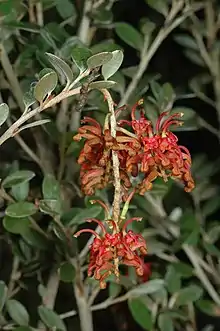Grevillea diminuta
Grevillea diminuta is a species of flowering plant in the family Proteaceae and is endemic to eastern Australia. It is a small, spreading shrub with elliptic to egg-shaped leaves and cylindrical to dome-shaped groups of reddish-brown flowers.
| Grevillea diminuta | |
|---|---|
 | |
| In the Australian National Botanic Gardens | |
| Scientific classification | |
| Kingdom: | Plantae |
| Clade: | Tracheophytes |
| Clade: | Angiosperms |
| Clade: | Eudicots |
| Order: | Proteales |
| Family: | Proteaceae |
| Genus: | Grevillea |
| Species: | G. diminuta |
| Binomial name | |
| Grevillea diminuta | |
Description
Grevillea diminuta is a spreading shrub that typically grows to a height of 0.3–1 m (1 ft 0 in – 3 ft 3 in). Its leaves are elliptic to egg-shaped, 6–20 mm (0.24–0.79 in) long and 3–9 mm (0.12–0.35 in) wide, the lower surface silky-hairy. The flowers are arranged in down-turned cylindrical to dome-shaped groups 20–60 mm (0.79–2.36 in) long and are reddish-brown and bright red inside, the pistil 10–11 mm (0.39–0.43 in) long. Flowering mainly occurs from September to December and the fruit is an elliptic, finely wrinkled follicle 10–15 mm (0.39–0.59 in) long.[2][3]
Taxonomy
Grevillea diminuta was first formally described in 1962 by Lawrie Johnson in Contributions from the New South Wales Herbarium from specimens collected by Ruurd Dirk Hoogland near Mount Franklin.[4] The specific epithet (diminuta) means "diminished".[5]
Distribution and habitat
This grevillea grows on rocky slopes in subalpine woodland on the Brindabella and Bimberi Ranges in the Australian Capital Territory and on the border with New South Wales.[2][3]
References
- "Grevillea dimidiata". Australian Plant Census. Retrieved 26 March 2022.
- "Grevillea diminuta". Australian Biological Resources Study, Department of Agriculture, Water and the Environment: Canberra. Retrieved 26 March 2022.
- Makinson, Robert O. "Grevillea diminuta". Royal Botanic Garden Sydney. Retrieved 26 March 2022.
- "Grevillea diminuta". APNI. Retrieved 26 March 2022.
- Sharr, Francis Aubi; George, Alex (2019). Western Australian Plant Names and Their Meanings (3rd ed.). Kardinya, WA: Four Gables Press. p. 184. ISBN 9780958034180.